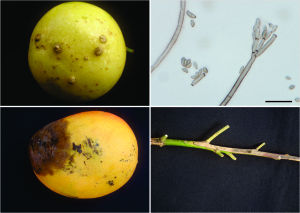André Wilson Campos Rosado (28/11/2017, 17:00 h). Currently, the modern taxonomy of fungi is based on the combination of morphology and molecular analyses. Although this polyphasic approach is increasingly used, many diseases caused by Cladosporiaceae and Botryosphaeriales have the identity of the causal agent still uncertain. Studies, based on molecular tools, investigating the diversity of these important groups of plant pathogenic fungi are still scarce in Brazil. Thus, the objectives of this study were to investigate the diversity of species of Cladosporiaceae and Botryosphaeriales associated with different crops, based mainly on molecular analyses, but also with morphological characterization for Cladosporiaceae, and to establish the phylogenetic relationship among the species found. Five previously described Cladosporium species were identified: Cladosporium maracuja (passionfruit and taro), C. pseudocladosporioides (kiwi), C. rectoides (passionfruit), C. subuliforme (passionfruit), and C. tenuissimum (cashew fruit, papaya, and passionfruit). While some isolates did not cluster with any known species, probably representing new species: Cladosporium sp. 1, Cladosporium sp. 2, Cladosporium sp. 3, Cladosporium sp. 4, and Cladosporium sp. 5, all occurring on passionfruit. Fourteen previously described Botryosphaeriales species were identified: Lasiodiplodia caatinguensis (Spondias dulcis), L. euphorbicola (avocado and Spondias tuberosa), L. gonubiensis (Spondias mombin), L. gravistriata (physic nut), L. jatrophicola (avocado and Spondias purpurea), L. pontae (avocado and Miconia sp.), L. pseudotheobromae (cashew and mango), L. theobromae (Anadenanthera sp., cacao, and passion fruit), Neofusicoccum algeriense (avocado), N. kwambonambiense (mango), N. parvum (mango), Neoscytalidium dimidiatum (coconut and physic nut), Phyllosticta citricarpa (Citrus reticulata), and Pseudofusicoccum stromaticum (mango). While other isolates did not cluster with any known species, representing putative new species: Lasiodiplodia sp. 1, Lasiodiplodia sp. 2, and Neofusicoccum sp. 1, occurring on Anadenanthera sp.; Begonia sp.; and avocado, cacao, and mango, respectively. This study reports nineteen new fungus-host combinations in Brazil, in addition to eight putative new species of Cladosporiaceae and Botryosphaeriales, which represents a contribution to the knowledge of the diversity of these important phytopathogenic fungi in Brazil.
Orientador: Olinto Liparini Pereira
Data e Hora: 28/11/2017 às 17:00 horas
Local: Auditório do ESB

